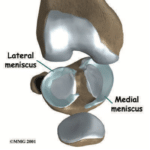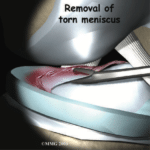WHAT IS IT?

Figure 1
The meniscal cartilages (medial and lateral) are C-shaped and sit between the two bones that form the knee: the femur (thigh bone) and the tibia (shin bone) (see Figure 1). They function primarily as shock absorbers and secondarily as stabilizers in the knee. The menisci commonly tear when they are caught between the moving bones of the knee. The menisci have blood supply only to the outer 1/3 and therefore have a limited ability to heal if torn. Most tears occur in the inner zones of the meniscus because this is the part of the meniscus that gets caught between the moving bones. These inner tears and many of the complex tears in the outer zone cannot heal.
HOW IS IT DIAGNOSED?
Pain is the most common symptom of a meniscal tear and is usually located on the sides or behind the knee. Catching and locking of the knee can also occur. Swelling, an indicator that something is wrong inside the knee, is commonly associated with meniscal tears. MRI scans are usually diagnostic of meniscal tears with an accuracy of about 90%. A thorough clinical exam followed by an MRI is the best method of diagnosing a meniscal tear.
HOW IS IT TREATED?

Figure 2
When the meniscus tears, the torn piece no longer has the capability to cushion the bone surfaces. If left alone, the tear can extend into previously normal cartilage causing more meniscus to be lost. Treatment of a meniscus tear depends on several factors including the type of tear, the activity level of the patient, and the response to non-operative treatments. When surgical treatment of a meniscus tear is required, the usual treatment is an arthroscopic menisectomy. During an arthroscopic procedure the torn, non-functioning, portions of the meniscus are removed (see Figure 2). Arthroscopy of the knee is performed by making two small one-centimeter incisions on the front of the knee. It is performed in an outpatient setting.
WHAT TO DO NEXT?
For your patients with a painful knee and associated symptoms, an MRI can confirm the diagnosis of a meniscal tear. Prompt referral will allow your patient to discuss their treatment options and minimize the risk of further damage. For patients undergoing knee arthroscopy, return to normal, non-sporting activities is just a few days, light sports (bicycling or swimming) can begin in 1-2 weeks and heavy sports (basketball, running, tennis) can take longer. The long-term prognosis depends on the size of the meniscal tear and any preexisting arthritis in the knee.
